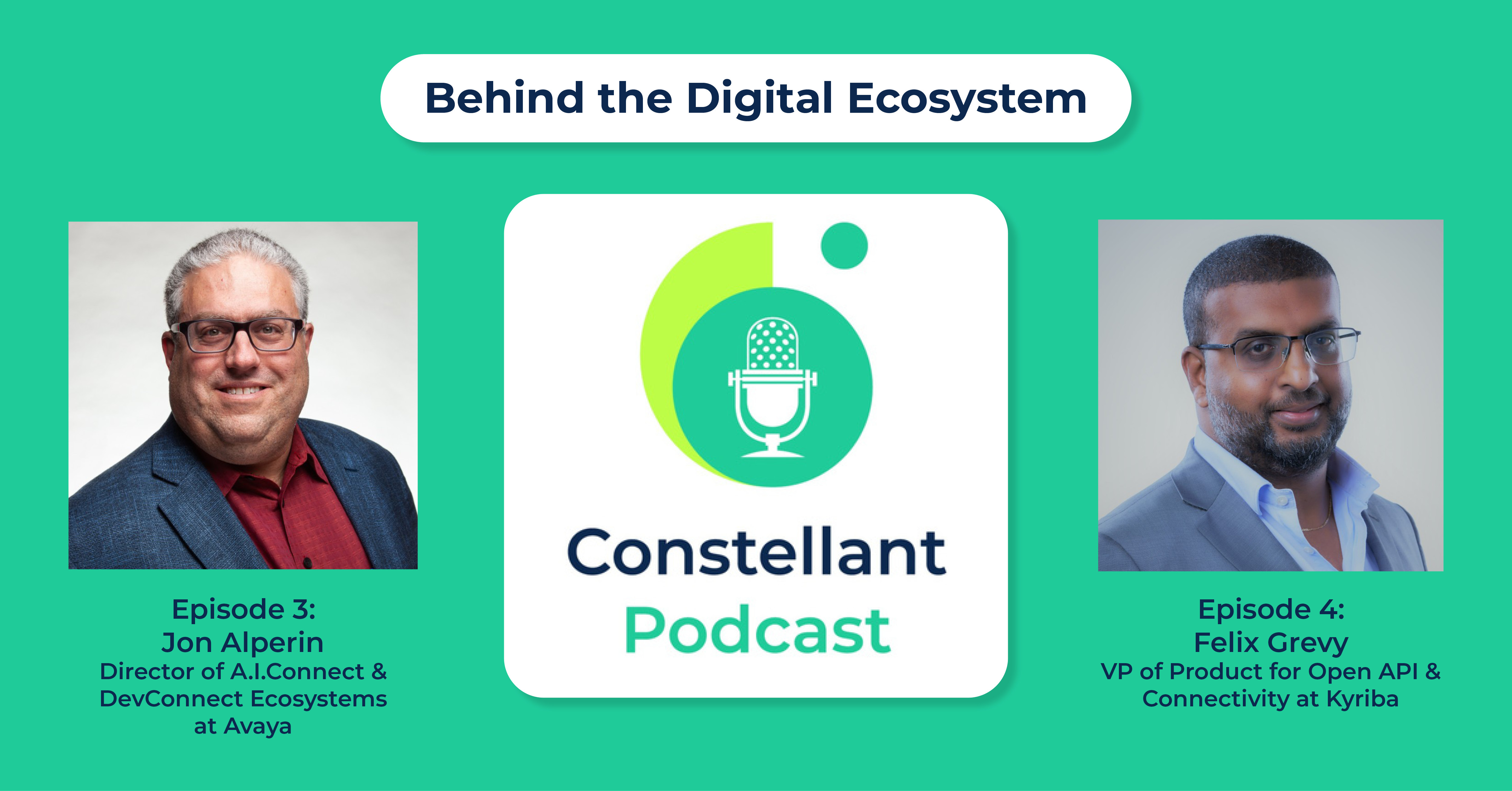The only ecosystem blog you'll ever need

Highlights from “Behind the Digital Ecosystem” Podcast Series: Episodes 3 & 4
March 23, 2021
We’ve had the privilege of connecting with digital ecosystem leaders over the past few months to interview them on how they have effectively built, managed, and scaled their ecosystems. These interviews, known as Behind the Digital Ecosystem, are available anywhere you can enjoy podcasts.
In the latest episodes, Constellant President and CEO Bhavesh Patel was joined by Jon Alperin, Director of A.I.Connect & DevConnect Ecosystems at Avaya and Felix Grevy, VP of Product for Open API & Connectivity at Kyriba. In case you aren’t a fan of podcasts, we’ve broken down some of the key insights for you in this blog:
- Triggers for building your ecosystem can come from anywhere, such as regulatory requirements.
Jon Alperin has a 30 year background in telecommunications and high-tech market. Most of that has focused on partnerships and strategic relationships. Alperin joined the company in 2001 and has been in his partnership role for 18 years. He has been running the DevConnect program for 10 years. Avaya is a global leader in collaboration and unified communications. They focus on helping their customers create experiences that change how they interact with their customers through digital channels.
The DevConnect program has its roots in the start of the company. Avaya’s products ran over the IP infrastructure and they saw value in having a program that led their customers to feel confident in their programs. In about 2007, they took the API information and decided to open it up into a developer program. They had tremendous success in doing this. They went from 100 to 400 developers in a 2-3 year timeframe, soon they had tens of thousands of developers.
- “In order to be a technology partner, you have to be a developer.”
Alperin says that as a developer, there is a natural growth toward a technology partner if what you are developing is not just for internal use. Avaya has worked hard to build bridges between these communities. Avaya has created a free developer program so there is a low cost of entry. For technology partners that start to formalize, Avaya has the ability to outfit their own labs, conduct compliance testing, and more. The developer side focuses on technical support that include paid options.
- Advice: Understand why you are building an ecosystem.
Alperin’s best advice to developers is to understand why you need an ecosystem and who you want to be a part of it. Some ecosystems are based around ‘what's in it for me?’ whether that is monetization or product creation. Alperin explains that ecosystems must also be built around customer choice and customer drivers in order to succeed.
- The key to achieving scalability is self-service.
Moving to episode 4, Felix Grevy of Kyriba shares his career path. With more than 20 years of experience working in tech, Grevy started out in France as a developer, specializing in building software for banks. After spending a couple years in Singapore, he returned to France as a product manager, building API platforms. Now Grevy is the VP of Product for Open API & Connectivity at Kyriba, an American company that helps corporations manage liquidity through SaaS products.
Grevy says there were many considerations in creating the ecosystem infrastructure. The developer needs to be able to register in a self-service way to a platform. They need to be able to sign up easily and get their registration approved so they can test the API. For companies that are not public, this can be very difficult. Signing up easily is the best way to achieve a scalable ecosystem without friction. This issue has gotten better over the past few years. When the ecosystem is easily accessible, it also allows developers to really focus on the content. Grevy urges developers to consider what is the best use of time.
- Kyriba is trying to shift towards an open API ecosystem.
In terms of the evolution of the ecosystem, Grevy says that Kyriba is fairly mature. That being said, the company wants to shift towards a public ecosystem and take advantage of open APIs. They are still in the building phase but plan to launch a public ecosystem this year. One of the first steps in doing this is to gather feedback from partners and customers.
- Ensure that Customers are Using the Right Software Versions to avoid friction
Scaling and managing an ecosystem comes with challenges. Grevy says that entering the ecosystem both from the consumer and developer side should be frictionless but that is not always the case. Fragmentation and different versions of applications can make it difficult for people to enjoy the ecosystem. This quickly creates frustration on both sides of the ecosystem. Grevy says this is a key challenge that needs to be identified immediately to avoid issues when managing an ecosystem. .
Interested in hearing more? Subscribe to Behind the Digital Ecosystem podcast series now.

